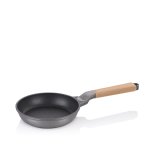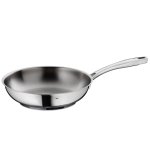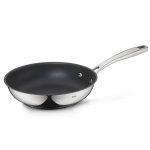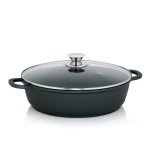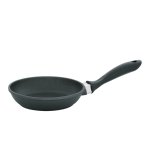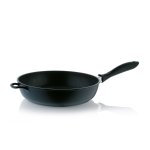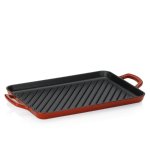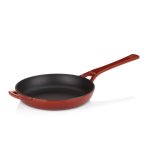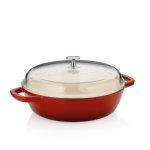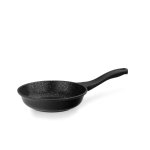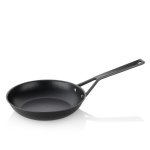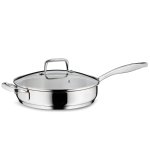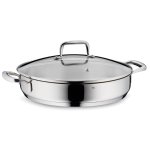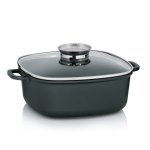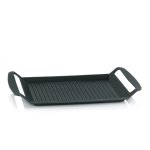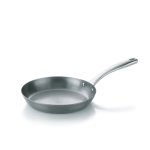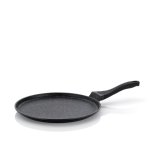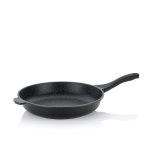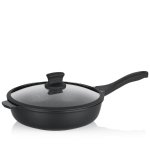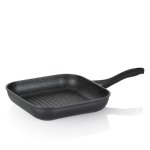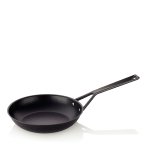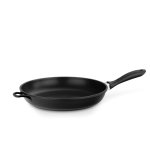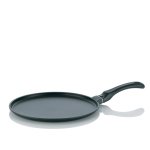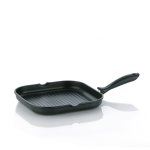- Bath
- Kitchen
- Collections
- Contact
- Company
- Catalogues

High-quality pans at kela
For your kitchen: coated frying pan, cast iron pan or braising pan made of the following materials: aluminium, iron, stainless steel.
-
Stewing pan FlavoriaItem No.: 10185
-
Serving pan FlavoriaItem No.: 10186
-
Serving pan KerrosItem No.: 11553
-
Griddle KerrosItem No.: 11564
-
Crêpe pan Stella NovaItem No.: 12223
-
Frying pan Stella NovaItem No.: 12224
-
Serving pan 32cm Stella NovaItem No.: 12226
-
Stewing pan 28 cm Stella NovaItem No.: 12227
-
Square griddle pan Stella NovaItem No.: 12228
-
Frying panItem No.: 12600
-
Frying pan KerrosItem No.: 15154
-
Crepe pan KerrosItem No.: 15155
-
Square griddle pan KerrosItem No.: 15156
-
Serving pan AturaItem No.: 15166
High quality pans – excellent frying pan
Like pots, pans are a fundamental part of every kitchen. And when it comes to frying pans, you don't just have one pan, but a wide selection. Pans differ mainly in material, but also in coating, size, and ultimately price. Additionally, certain dishes turn out even better in special pans. Kela therefore attaches great importance to quality, function, and design, ensuring the best cooking and frying results can be achieved in your own kitchen.
We are particularly proud of the Stella Nova cookware collection, which won the 2020 German Design Award in the “Excellent Product Design” category. This cast aluminium collection has a new surface structure which guarantees the best frying and cooking results. More information about the complete Stella Nova collection can be found on the respective product pages.
Pans made of different materials for your kitchen
The selection of pans is large and it is easy to become confused. But which pan is the right one? What do I mainly want to use the pan for when cooking? Which size is appropriate? Does the pan need a coating? And most importantly, what are the different materials?
As a general rule, food will not stick to pans with an intact coating. Cast aluminium/coated aluminium pans are considered all-rounders in the kitchen. Iron or copper pans are certainly not suitable for everyday use, but they are definitely the first choice for certain frying results. Thus, it’s perfect for all hobby cooks and those with somewhat more sophisticated requirements.
Cast aluminium pans
Cast aluminium pans with a non-stick coating are lightweight and perfect for low-fat frying. Despite little fat, the food does not burn or stick. The pans absorb heat well and ensure even heat distribution, so that cooking is particularly energy-efficient. Cast aluminium pans are part of the basic equipment in every kitchen since they are true all-rounders. They are among the lightest pans and are easy to handle due to their low weight. In the production of cast aluminium pans, a molten aluminium alloy is transferred to a mould and pressed into shape. The cookware is therefore free from material stresses. One of our favourite pans – the Kerros frying pan.
Iron frying pans
kela iron pans are made of carbon steel and consist of 99% iron. Carbon steel is food-friendly due to its high iron content and also environmentally friendly by avoiding chemical substances. Iron pans must be baked before their first use to achieve a natural non-stick effect, as is the case with our Ferrum series. Our range also includes frying pans made of iron that have already been pre-baked using a special process. Iron frying pans are perfect for dishes that require very high heat, such as steaks. The meat cooks perfectly, develops the full roast aromas due to the high roasting temperatures and remains beautifully juicy on the inside. Moreover, iron pans feature robustness and a long lifespan.
Stainless steel pans
Stainless steel pans are among the all-rounders in the kitchen. They are easy to clean, rustproof and good heat retainers. If the handle is also made of stainless steel, the pans can be placed in the oven at up to 300° C. Stainless steel pans are also absolutely odourless and tasteless. In summary, stainless steel pans, like iron pans, are heat resistant, extremely strong and durable. Stainless steel pans are also very easy to clean and maintain. Take a look at our Cailin frying pan.
Copper pans
Copper pans have the best heat conductivity. They react very quickly to changes in heat and are excellent heat retainers. Pans made of copper are perfect for cooking on a gas stove. They are also particularly popular in the kitchens of professional chefs. Last but not least, these pans feature an attractive design.
Cast iron pans
Cast iron pans are particularly robust and durable and are perfect for searing. Cooking and frying with cast iron pans require some practice. To prevent food from sticking during frying, an uncoated cast iron pan must be well baked. Cast iron pans from kela have a coating that makes frying easier. However, fat is needed during preparation, because the non-stick effect is not quite strong enough to fry completely fat-free. Cast iron pans store heat excellently. However, they are somewhat more cumbersome to handle due to their heavy weight.
Aluminium pans
Aluminium pans with a non-stick coating are, like cast aluminium pans, particularly light and perfect for low-fat frying. Dishes can be prepared even with a small amount of fat without sticking. In addition, these pans absorb the heat well and distribute it efficiently. An aluminium pan is either pressed or forged and, because of these manufacturing processes, is often priced slightly below comparable pans made of cast aluminium. More information about our Stoneline aluminium pan can be found on the respective detail pages.
Which pan for what? Stewing pan or frying pan?
Consumers are faced with so many different materials for frying pans, and so many special pans to choose from. The question of which pans are important does not only arise for young people when equipping their kitchen for the first time. Good amateur and professional chefs also appreciate the different properties and use them to achieve a perfect frying result. We would now like to take a closer look at which pans should actually be found in your kitchen cupboards, in which size and which pan is the most suitable for gentle frying or for particularly hot searing.
Aluminium or cast aluminium pans with a non-stick coating are generally a good choice for basic cookware. They can be used to make almost any dish. You can then add to your own range of pans according to your preferences and wishes. We generally recommend matching lids to the pans, so that you can cook in a highly energy-efficient way.
The question of stewing pan or frying pan, on the other hand, can be answered relatively quickly. A stewing pan is just as suitable for frying as a frying pan, but stewing pans have a higher rim. A stewing pan also comes with a lid, since sautéing is always followed by stewing in liquid.
Coated frying pan / grill pan
Frying pans with a non-stick coating are suitable for all dishes that do not require extremely high heat including egg dishes, pancakes, even delicate meat, such as chicken and of course fish. Since coated frying pans do not tolerate extremely high heat, they are not suitable for steaks and meat that is seared at the highest level. It is important to pay attention to the coating when buying, since there are differences in terms of non-stick properties, scratch resistance and corrosion protection.
Grill pans are perfect for bringing that barbecue feeling into the kitchen even during winter. Grill pans have a ribbed bottom, which gives the food the typical grill stripes. Juicy meat, as well as vegetables or tender fish are perfect for preparation in grill pans. To enable low-fat frying, these pans are also mostly non-stick coated. Grill pans are generally suitable for all types of cookers. Rectangular shapes are particularly practical, because they offer more space for preparation.
Good, cast iron stewing pan
High-quality cast-iron pans are extremely robust and durable. They store heat very well and distribute it evenly during preparation. Cast iron pans are perfect for searing, releasing the roasted flavours to their fullest. These pans are generally suitable for all types of cookers, and their high heat resistance also makes them ideal for preparation in the oven. Cast iron pans are available with and without enamel coating. The more affordable variants are those without coating. The higher-quality pans with enamel coating feature the additional advantages of being unaffected by acidic foods and much easier to clean. A natural patina is formed through baking and use.
Stewing pans are special pans that have a particularly high rim, which ensures that the liquid does not boil out during stewing and cooking. These pans are best suited for the preparation of vegetables. Cast iron, cast aluminium as well as copper are suitable materials for stewing pans due to their good heat conductivity. Suitable lids are recommended for stewing pans so that braising or stewing in liquid after browning, can be done slowly.
Fish pan
Fish pans are most obviously distinguished from other pans by their shape. They are often elongated and large enough so that fish can be fried whole in them. When preparing fish, it is important to have a good non-stick coating so that the delicate food does not burn or stick. The special shape of these pans also makes them very suitable for serving. Tip: if the pan smells of fish after preparation, simply rub it with lemon.
Crêpe pan
A striking feature of crêpe pans is the very low rim. This is particularly practical for easy turning and subsequent tilting of the finished crêpes. Crêpe pans should definitely have a non-stick coating so that the crêpes or pancakes can be prepared with little fat and won’t stick and crack when flipped. It is important for crêpe pans to distribute heat evenly, so the bottom of the pan should not be too thin. Cast aluminium is the most suitable material. Cast iron distributes the heat optimally, but its non-stick effect may not be quite as good. The rather special crêpe pan is also perfect for preparing fried eggs.
Wok
Cooking in a wok is not only trendy, but the dishes are often prepared quickly and the special way of cooking ensures that the vitamins and nutrients of fresh vegetables are very well preserved. For cooking in a wok, it is important that the material conducts heat well, which is why our woks are made of cast iron and cast aluminium. What is special about cooking with a wok? The ingredients are briefly sautéed over high heat during preparation and then re-cooked on the high sides of the wok. Stir-frying is a typical method of cooking with a wok. The wok is also a very good choice for braising, steaming and deep-frying. How about the Asia wok set?

High quality coatings for our pans
Frying pans with a non-stick coating are recommended for beginners and especially for normal, everyday use. The coating enables low-fat or even fat-free cooking and the food will not stick to the pan. Of course, there are also big differences in the coatings. We only use high-quality coatings without PFOA for our cookware such as the Greblon C3+ coating from Weilburger in Germany. In general, non-stick coatings differ in the number of layers and special reinforcements. Coatings with a ceramic seal are particularly scratch-resistant and more durable than many other coatings. Pans with non-stick coatings should not be heated very strongly, otherwise the surface may discolour, the pan may lose non-stick properties or ultimately the coating may be destroyed. Unfortunately, the fact of the matter with non-stick pans is that no coating lasts forever. Heat, sharp knives, improper cleaning—all these are factors that can damage a coating. The lifespan of a pan with a non-stick coating is certainly less than that of a cast iron or copper pan.
Large pan
Essentially, there are pans from about 18 to 32 centimetres in diameter. Large pans are those with a diameter of 30 cm or more. One of our large frying pans is the Kerros frying pan. Which pans you need in your kitchen depends first and foremost on the size of your household. For single households, pans of 20 cm and 24 cm are often sufficient. Pans with a diameter of 28 cm are among the most popular. This size is also perfect for families of three to five people. Furthermore, the size of the pan depends on the dish. Small pans are perfect for fried eggs, small pancakes or to briefly sauté onions or herbs. In some cases, pans with a diameter of 32 cm are available. Even larger versions are only found in major catering establishments. A variant that makes the most of the space are oval and especially square pans and griddles.
Instructions for care and use of the frying pans
Cleaning frying pans
An important prerequisite for a long life of the pans is that no sharp or pointed objects are used for cooking. You should also never cut on the coatings, in other words, directly in the pan. For pans with non-stick coating, another important factor is that the pans should not get overheated. Pans with non-stick coating are not suitable for hot frying.
We generally recommend cleaning by hand, although many pans are dishwasher safe. The best way to clean it is to wash it under running water with a little washing-up liquid and a soft dishcloth. More stubborn residue from frying can be removed with a plastic dish brush. Please do not use scratchy cleaning sponges or scouring pads on coated pans. After washing, pans should always be dried very well with a tea towel.
Please never stack pans on top of each other without pan protectors, since this can also damage the coating. A pan guard is recommended for stacking pans to save space.





